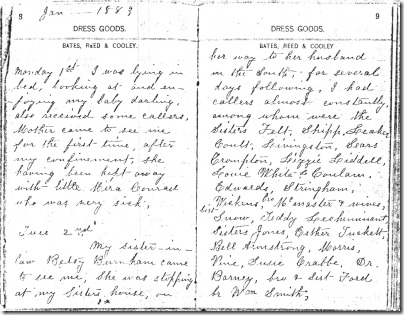“I'm running my hands over the homemade necklace my daughter made me for Mother's Day. Its soft foam and wooden blocks make it the sort of thing every Mom cherishes. She handed it today to me with great pride during her preschool celebration, thrilled I would wear it back to work and show it off on my blog. Work and motherhood -- something I'm not sure how I would have managed were it not for The Pill. You see, like many women, I timed both of my pregnancies. I had control over the reproduction part of sex during my now 10-year marriage. I could decide at what point during my journalism career I was ready for children, and we could plan parenthood right along with my climb up the ladder. Giving women control over reproduction means giving them control over their own fate. I am a wife, a blogger, a mother -- when I want, how I want, and with the freedom to remain sexual. The pill means I can have it all, and sacrifice nothing.”
Erin Kotecki Vest is Political Director and Producer of Special Projects for BlogHer, Inc.
“In 1962, when I was a 22-year-old Holly Golightly-wannabe living in Greenwich Village with my dog and my motor scooter, two events had a seismic effect on my life. Helen Gurley Brown wrote Sex and the Single Girl, and my doctor at the time (Shepard Aronson, who would become one of the first male members of the National Organization for Women) wrote me a prescription for The Pill.  Each in its way was transformative. Brown's book, which was both frisky and practical, acknowledged what millions had known but denied -- that nice girls "did it" and sometimes even enjoyed it, and that sex need not lead to marriage. In 1962, this was considered shocking. The impact of The Pill was even more radical. It meant sex need not lead to pregnancy. But it wasn't just another form of contraception, it was an equalizer, a liberator, and easy to take. For the first time in human history, a woman could control her sexuality and determine her readiness for reproduction by swallowing a pill smaller than an aspirin. Critics warned that The Pill would spawn generations of loose, immoral women; what it spawned was generations of empowered women who are better equipped to make rational choices about their lives. Though it took a while--and the dogged efforts of the feminist health activist, Barbara Seaman--for its creators to get the dose right and add a printed insert informing women of its possible side effects, The Pill bore revolutionary results. It allowed women to become autonomous decision-makers rather than captives of our biology (though many wives, daughters, and girlfriends took it secretly because of the stigma attached to women who assume any sexual initiative). It meant involuntary pregnancy could no longer be used as threat or punishment for female sexual activity. It gave us the power to decide if and when we were physically, emotionally, and financially prepared for the immense commitment to bear and raise a child. It helped us plan and space our families. It helped us plan and build careers, or just keep our jobs. (In 1962, employers could, without penalty, fire a woman who got pregnant.) Since wanted children are often better cared for than unwanted children it meant that more kids were wanted, grew up healthy, supported, and loved. Children like the three my husband and I conceived when I went off the pill once we made the choice to have a family; or like our six grandchildren, all planned. If my Holly Golightly years had produced an unwanted child, I, who was entirely self-supporting, would have been derailed by joblessness and that child would have been raised in poverty. What's more, I would never have met my beloved husband of 46 years, and my adored children and grandchildren would never have been born.”
Each in its way was transformative. Brown's book, which was both frisky and practical, acknowledged what millions had known but denied -- that nice girls "did it" and sometimes even enjoyed it, and that sex need not lead to marriage. In 1962, this was considered shocking. The impact of The Pill was even more radical. It meant sex need not lead to pregnancy. But it wasn't just another form of contraception, it was an equalizer, a liberator, and easy to take. For the first time in human history, a woman could control her sexuality and determine her readiness for reproduction by swallowing a pill smaller than an aspirin. Critics warned that The Pill would spawn generations of loose, immoral women; what it spawned was generations of empowered women who are better equipped to make rational choices about their lives. Though it took a while--and the dogged efforts of the feminist health activist, Barbara Seaman--for its creators to get the dose right and add a printed insert informing women of its possible side effects, The Pill bore revolutionary results. It allowed women to become autonomous decision-makers rather than captives of our biology (though many wives, daughters, and girlfriends took it secretly because of the stigma attached to women who assume any sexual initiative). It meant involuntary pregnancy could no longer be used as threat or punishment for female sexual activity. It gave us the power to decide if and when we were physically, emotionally, and financially prepared for the immense commitment to bear and raise a child. It helped us plan and space our families. It helped us plan and build careers, or just keep our jobs. (In 1962, employers could, without penalty, fire a woman who got pregnant.) Since wanted children are often better cared for than unwanted children it meant that more kids were wanted, grew up healthy, supported, and loved. Children like the three my husband and I conceived when I went off the pill once we made the choice to have a family; or like our six grandchildren, all planned. If my Holly Golightly years had produced an unwanted child, I, who was entirely self-supporting, would have been derailed by joblessness and that child would have been raised in poverty. What's more, I would never have met my beloved husband of 46 years, and my adored children and grandchildren would never have been born.”
Letty Cottin Pogrebin is a founding editor of Ms. Magazine, a founder of the National Women's Political Caucus, and the author of nine books, most recently the novel, Three Daughters.
And, on this day in 1869, a golden spike was driven at Promontory, Utah, marking the completion of the first transcontinental railroad in the United States.
 Saul Bellow, Larry Brown, John Updike, Ernest Hemingway, Herman Melville, Howard Nemerov, J. D. Salinger, Walt Whitman, Roberto Bolano, Stieg Larsson, Howard Zinn, Michael Harrington, Che Guevara, Karl Marx, Leon Trotsky, Emma Goldman, Antonio Gramsci, Socrates, Friedrich Nietzsche, Hans-Georg Gadamer, Benedict Spinoza, Jackson Pollock, J. S. Bach, John Lennon, George Harrison, Francois Truffaut, Ingmar Bergman, Stanley Kubrick, Ozu Yasujiro, Kurosawa Akira, Dalton Trumbo, Dennis Hopper, Gulf of Mexico…
Saul Bellow, Larry Brown, John Updike, Ernest Hemingway, Herman Melville, Howard Nemerov, J. D. Salinger, Walt Whitman, Roberto Bolano, Stieg Larsson, Howard Zinn, Michael Harrington, Che Guevara, Karl Marx, Leon Trotsky, Emma Goldman, Antonio Gramsci, Socrates, Friedrich Nietzsche, Hans-Georg Gadamer, Benedict Spinoza, Jackson Pollock, J. S. Bach, John Lennon, George Harrison, Francois Truffaut, Ingmar Bergman, Stanley Kubrick, Ozu Yasujiro, Kurosawa Akira, Dalton Trumbo, Dennis Hopper, Gulf of Mexico…










